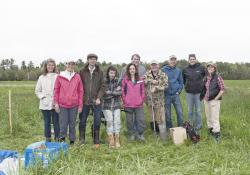Research and Resources
Publications
- Arndt, K.A., E.E. Campbell, C. D. Dorich, A.S. Grandy, T. Griffin, P. Ingraham, A. Perry, R. K. Varner, A.R., Contosta,. 2022. Initial soil conditions outweigh management in a cool-season dairy farm's carbon sequestration potential. Science of the Total Environment. Volume 809, 25 February 2022, 152195. Available at https://www.sciencedirect.com/science/article/pii/S0048969721072715
- Contosta, A.R., Arndt, K.A., Campbell, E.A., Grandy, A.S., Perry, A., and Varner, R.K.. 2021. Management intensive grazing on New England dairy farms enhances soil nitrogen stocks and nitrous oxide emissions while having little effect on soil carbon. Agriculture, Ecosystems & Environment. 317:107471. Available at https://www.sciencedirect.com/science/article/pii/S0167880921001754
Presentations
- Contosta, A.R. 2020 and 2021. “Grazed and Confused? Demystifying the potential for pasture management to increase soil carbon storage on New England dairy farms.” Introduction to Soil Science, University of New Hampshire, Durham, NH.
- Contosta, A.R. 2020. “Soil and carbon sequestration.” Maine Organic Farmers and Growers Farmer to Farmer Conference, Virtual.
- Contosta, A.R. 2020. “Grazed and Confused? Demystifying the potential for pasture management to increase soil carbon storage on New England dairy farms.” Antioch University New England, Keene, NH, Virtual
- Contosta, A.R. 2019. “Grazed and Confused? Demystifying the potential for pasture management to increase soil carbon storage on New England dairy farms.” Tufts University Friedman School of Nutrition Science and Policy, Boston, MA. Available at https://nutrition.tufts.edu/event/2019-10-09/friedman-speaker-series-alix-contosta
- Contosta, A.R. 2019. “Grazed and Confused? Demystifying the potential for pasture management to increase soil carbon storage on New England dairy farms.” University of Massachusetts Stockbridge School of Agriculture Seminar Series, Amherst, MA.
- Campbell, E.E., Constosta, A.R., Grandy, A.S., Salas, W., Ingraham, P., and Varner, R.K. 2019. “Consequences of intensive rotational grazing on soil carbon versus nitrogen.” American Geophysical Union Annual Meeting, San Francisco, CA.
- Contosta, A.R. 2018. “Agricultural practices, soil carbon, and climate change.” Slow Living Summit, Brattleboro, VT. Abstract available at https://ui.adsabs.harvard.edu/abs/2019AGUFM.B31F2448C/abstract
- Contosta, A.R. and Campbell E.A. 2018 and 2019. “Soil carbon and climate change in smallholder agriculture.” Massachusetts Institute of Technology, D-Lab, Cambridge, MA.
- Contosta, A.R. 2017. “Pastoralization and the next 100 years of land use change in New England.” Harvard Forest Annual Symposium, Petersham, MA. Abstract available at https://harvardforest2.fas.harvard.edu/asp/hf/php/symposium/symposium_abstract_view.php?id=4066
- Campbell, E.E., Dorich, C., Contosta, A.R., and Varner, R.K. 2017. “Simulating grazing practices in a complete livestock system model: estimating soil carbon storage and greenhouse gas emissions in conventional versus organic dairy agroecosystems in New England using the Manure-DNDC model.” American Geophysical Union Annual Meeting, New Orleans, LA. Abstract available at https://ui.adsabs.harvard.edu/abs/2017AGUFM.B11E1722C/abstract
- Contosta, A.R. 2016. “Carbon benefits and greenhouse gas costs of expanding grass-based farming in New England.” Harvard Forest Grazing and Conservation Workshop, Petersham, MA.
Poster
Tradeoffs Between Soil Carbon Sequestration and Greenhouse Gas Emissions in Grazed Pastures of Northeastern US Organic Dairy Farms, Alexandra Contosta, University of New Hampshire Download the Poster
Abstract: Management intensive grazing (MIG)—the most popular approach to pasturing on organic dairy farms in the northeastern U.S. —can potentially remove carbon (C) from the atmosphere and store it in soil. However, increased soil C storage may cause higher soil nitrous oxide (N2O) emissions, offsetting any gains in climate mitigation achieved with MIG. The goal of our project is to provide organic dairy farmers and industry partners with science-based information and decision support systems on grazing practices that maximize soil C sequestration and minimize soil GHG losses. Specific objectives include: 1) quantifying SOC stocks at three organic dairy farms in the Northeast under MIG; 2) investigating drivers of soil C stabilization with MIG; 3) measuring soil N2O emissions in grazed and ungrazed pastures and comparing them to C stocks; 4) developing a grazing-specific version of the biogeochemical model Manure-DNDC; 5) refining the Northeast Dairy Emissions Estimator (NDEE) decision support system using the updated model; 6) hosting workshops that train stakeholders to use the NDEE; 7) broadly disseminating research results and products through eOrganic and the USDA Northeast Climate Hub; and 8) using feedback from workshops to define future research questions. These activities are highly relevant to Organic Transitions program by documenting the effects of organic practices on greenhouse gas mitigation and improving a model for estimating soil C and greenhouse gas dynamics (Priorities 1 and 2). They are also critical for improving the sustainability of organic dairy production in the northeastern U.S., which comprises 20% of national organic milk sales.
The significance of the project to organic agriculture: Management intensive grazing (MIG) is a practice where large numbers of livestock graze on a small pasture for a short period before moving onto the next paddock. While organic and non-organic dairy farms alike have adopted MIG, organic farms are more likely to employ this pasture management technique to meet National Organic Program (NOP) requirements for dry matter intake. The soil carbon storage potential of MIG has been a topic of considerable recent interest for mitigating climate change. Even if MIG has the benefit of sequestering carbon in soil, an unintended consequence may be higher emissions of other greenhouse gases, such as nitrous oxide. There is currently no rigorous assessment of whether and how MIG results in higher soil carbon stocks and greenhouse gas emissions in Northeastern dairy farms. To our knowledge, our study is the first of its kind to perform this assessment in order to develop a decision-support tool that will enable farmers, service providers, and industry partners to compare tradeoffs in forage productivity, soil organic matter development, and greenhouse gas losses with intensive grazing management.
2016 Annual Report
Funding

This project has received funding in 2012 by the Organic Transitions Program (ORG), part of the USDA National Institute of Food and Agriculture, grant number 2015-51106-23967.



